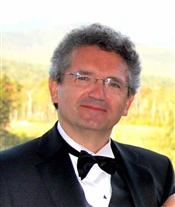Program Information
In Memoriam of Michael Goitein: Milestones in Treatment Planning, Biophysical Modeling, and Delivery of Proton Therapy

G Goitein
C Ling
R Mohan
A Niemierko
G Goitein1*, C Ling2*, R Mohan3*, A Niemierko4*, (1) Windisch, CH, (2) Varian Medical Systems, New York, NY, (3) UT MD Anderson Cancer Center, Houston, TX, (4) Department of Radiation Oncology, Wayland, MA
Presentations
4:30 PM : Memorial Lecturer: In the Spirit of a Pioneer - G Goitein, Presenting Author4:50 PM : Mulling over Michael Goitein's significant contributions to radiotherapy treatment planning - C Ling, Presenting Author
5:10 PM : Evolution of proton therapy from the 1970's to today: Michael Goitein's impact - R Mohan, Presenting Author
5:35 PM : Biophysical Modeling - A Niemierko, Presenting Author
WE-G-FS2-0 (Wednesday, August 2, 2017) 4:30 PM - 6:00 PM Room: Four Seasons 2
Michael Goitein was one of the most influential Medical Physicists of our time. He passed away on August 3rd, 2016. This symposium will honor Michael’s numerous and far-reaching contributions in treatment planning, biophysical modeling, and proton therapy. We will discuss how Michael’s accomplishments have affected the treatments we deliver today and how they may influence future developments.
In treatment planning, Michael was a pioneer in iterative reconstruction of CT images and he was instrumental in integrating the new (at that time) CT images into 3D treatment planning. He developed - or co-developed with others - a number of treatment planning tools that we take for granted today: support for non-coplanar beam directions, color-wash display of dose distributions on top of anatomy, digitally reconstructed radiographs, and last but not least the dose-volume histogram. From early on he pushed for the inclusion of error bars in every physics measure, and for displaying error margins in the treatment planning systems. This latter advice has been largely ignored by our community – until very recently.
Michael saw the importance of including biological understanding in the treatment planning process. Together with Andrzej Niemierko he developed biophysical models for the non-uniform irradiation of tumors, and showed that the minimum tumor dose is not as important as people generally believe. This insight led to successful clinical strategies in treating tumors directly abutting critical structures such as the brainstem.
The work for which Michael is known and respected the most is his work in proton therapy. Together with the team at the Harvard Cyclotron Laboratory, Michael developed various approaches to understand and compensate the impact of tissue inhomogeneities on proton dose distributions. He developed a treatment planning program for proton treatment of ocular tumors, which – in modified form – is still in use today. He developed image guidance and immobilization techniques specifically for proton therapy. He was also instrumental in the design and execution of clinical trials in proton therapy and comparison with photon therapy. Perhaps most importantly, he and Herman Suit designed the first commercially built hospital-based proton therapy center at the Massachusetts General Hospital, which served as a model for subsequent developments. Michael’s work has in many ways laid the foundation of the rapid rise and strong standing of proton therapy today.
Learning Objectives:
1. Review Michael Goitein’s contributions in treatment planning, biophysical modeling, and proton therapy
2. Discuss how those contributions had practice-changing impact
3. Discuss future perspectives of proton therapy
4. What you can learn from a giant in the field for your own career
Handouts
- 127-35429-418554-127621.pdf (G Goitein)
- 127-35430-418554-127625.pdf (C Ling)
- 127-35431-418554-126684.pdf (R Mohan)
- 127-35432-418554-126729.pdf (A Niemierko)
Contact Email:



